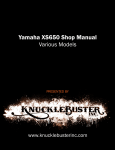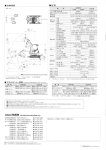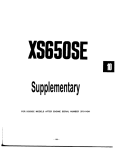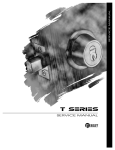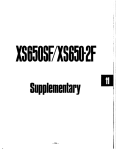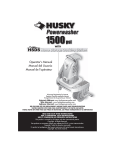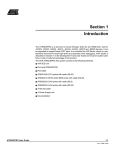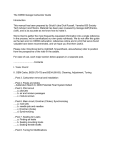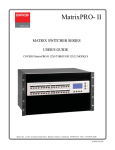Download 650H/SH Supplement
Transcript
INDEX This manual has been combined with previous service manuals to provide complete service information for: XS650H/SH. Please read and give special consideration to the “NOTICE” on the preceding page for your safety. XS650H/SH SUPPLEMENT XS650 MODELS 1978-80 FOREWORD This Supplementary Service Manual has been prepared to introduce new service and new data for the XS650H/XS650SH. For complete information on service procedure, it is necessary to use this Supplementary Service Manual together with following manuals: ’ XS650E Service Manual (LIT-11616-00-76) ! XS650SE Supplementary Service Manual (LIT-11616-01-08) ’ XS650SF/2F Supplementary Service Manual (LIT-11616-01-65) XS650G/SG Supplementary Service Manual (LIT-1 1616-01-75) I 1 SERVICE DEPT. INTERNATIONAL DIVISION YAMAHA MOTOR CO., LTD. NOTE: This Supplementary Service Manual contains information regarding periodic maintenance to the emission control system for the XS650H/XS650SH. Please read this material carefully. NOTICE This manual was written by the Yamaha Motor Company primarily for use by Yamaha dealers and their qualified mechanics. It is not possible to put an entire mechanic’s education into one manual, so it is assumed that persons using this book to perform maintenance and repairs on Yamaha motorcycles have a basic understanding of the mechanical concepts and procedures inherent to motorcycle repair technology. Without such knowledge, attempted repairs or service to this model may render it unfit for use and/or unsafe. This model has been designed and manufactured to perform within certain specifications in regard to performance and emissions. Proper service with the correct tools is necessary to ensure that the motorcycle will operate as designed. If there is any question about a service procedure it is imperative that you contact a Yamaha dealer before continuing. Before attempting any service, check with your Yamaha dealer for any service information changes that apply to this model: This policy is intended to provide the customer with the most satisfaction from his motorcycle and to conform with federal environmental quality objectives. Yamaha Motor Company, Ltd. is continually striving to further improve all models manufactured by Yamaha. Modifications and significant changes in specifications or procedures will be forwarded to all Authorized Yamaha dealers and will, where applicable, appear in future editions of this manual. I - Particularly important information is distinguished in this manual by the following notations: NOTE : A NOTE provides key information to make procedures easier or clearer. CAUTION: A CAUTION indicates special procedure that must be followed to avoid damage to the motorcycle. A WARNING indicates special procedures that must be folWARNING: lowed to avoid injury to a motorcycle operator or person inspecting or repairing the motorcycle. Starting Serial Number XS650H H . . . . . . . . . . . . . 4N9-000101 XS650SH H . . . . . . . . ..__. 4M4-000101 MAINTENANCE AND LUBRICATION CHART PERIODIC MAINTENANCE EMISSION CONTROL SYSTEM - 3 c t c B. PICK-UP COIL ASSEMBLY The method of mounting the pick-up coil assembly is changed for easier service work. Thus, the followings “Pick-up coil assembly removal” and “Pick-up coil assembly reinstallation” should be changed. *ENGINE A. IGNITION TIMING The ignition system is modified for easier maintenance. Thus, the following “ignition timing check” should be changed, Pick-up coil assembly removal Remove the pick-up coil securing screws and remove the pick-up coil assembly. Ignition timing check 1. Ignition timing is checked with a timing light by observing the position of the rotor pointer and the marks stamped on the timing plate. The timing plate is marked as follows. “ll” Firing range for No. 1 (L.H.) “T” Top Dead Center for No. 1, fL.H.1 cylinder 2. Connect the timing light to the left cylinder spark plug lead wire. 3. Start the engine and keep the engine speed as specified. Use a tachometer to check the engine speed. L_ 4. Pick-up coil assembly reinstallation Install the pick-up coil assembly on to the stator assembly. C. FUEL LEVEL The carburetor is furnished with a drain screw to provide easy access to service work. Thus, the following “Fuel level measurement” should be added. Specified engine speed: 1,200 r/min The rotor pointer should be within the limits of ” fl ” on the timing plate. If it exceeds the limits or does not steady, check the timing plate for tightness and/or ignition system for damage. Fuel level measurement NOTE: Before checking the fuel level, note the following: 1. Place the motorcycle on a level surface. 2. Adjust the motorcycle position by placing a suitable stand or a garage jack under the engine so that the carburetor is positioned vertically. NOTE: Ignition timing is not adjustable. 1. 2. -5 Connect the level gauge (special tool) or a vinyl pipe of 6 mm (0.24 in) in inside diameter to the float bowl nozzle left or right side carburetor. Set the gauge as shown and loosen the drain screw. Fuel level: 1 f 1 mm (0.04? 0.04 in) above from the carburetor mixing chamber body edge. YL___-A 3. Start the engine and stop it after a few minutes of run. This procedure is necessary to obtain the correct fuel level. NOTE: Make sure the fuel petcock is “ON” or “RES” oosition. 4. 6. If the fuel level is incorrect, remove the carburetor assembly from the motorcycle and check the fuel valve(s) and float assembly(s) for damage. 7. If no damage is found, correct the fuel level by slightly bending the float arm tang. Recheck the fuel level. Note the fuel level and bring the gauge to the other end of the carburetor line and repeat step 3 above. Note the fuel level again and compare it with the previous gauge reading. They should be equal. If not, place a suitable size of wooden piece or the. alike under the center stand and adjust. D. ENGINE OIL LEVEL MEASUREMENT 1. Place the motorcycle on the center stand. Warm up the engine for several minutes. 5. Check the fuel level one by one. The level should be in the specified range. NOTE: Be sure the motorcycle is positioned straight up when checking the oil level; a slight tilt toward the side can produce false readings. -6Y 2 With the engine stopped, check the oil level through the level window located at the lower part of the right side crankcase cover, or screw the dip stick completely out and then the stick in the hole. NOTE: Wait a few minutes until the oil level settles before checking. When checking engine oil level with the dip stick, let the unscrewed dip stick rest on the case threads. 1. Dip stick 2. Maximum level 3. Minimum level 3. The oil level should be between maximum and minimum levels. If the level is lower, add sufficient oil to raise it to the proper level. l- *CHASSIS A. REAR WHEEL REMOVAL 1. Place the motorcycle on the center stand. 2. Remove the tension bar and the brake rod from the brake shoe plate. The tension bar can be removed by removing the cotter pin and nut from the tension bar bolt. The brake rod can be removed by removing the adjuster. b. Make sure the axle nut is properly torqued and a new cotter pin is installed. 15.0 m-kg (108.5 ft-lb) c. Adjust the drive chain. 8. DRIVE CHAIN TENSION CHECK 1. Adjusfer 2. Brake rod 3. Tenrio” bar 3. Disconnect the drive chain. 4. Loosen the chain tension adjusting nuts and bolts on both sides. 5. Remove the axle nut cotter pin and axle nut. Discard the old pin. Remove the axle shaft and the wheel. For reassembly, follow the procedure below with care: a. Make sure the drive chain master link is correctly installed with rounded end in direction of chain travel. 6. 7. NOTE: Before checking and/or adjusting, rotate rear wheel through several revolutions and check tension several times to find the tightest Check and/or adjust chain tension point. with rear wheel in this “tight chain” position. Inspect the drive chain with the center stand put up. Check the tension at the position shown in the illustration. The normal vertical deflection is approximately 20 - 30 mm (0.8 - 1.2 in). If the deflection exceeds 20 - 30 mm (0.8 - 1.2 in) adjust the chain tension. C. DRIVE CHAIN TENSION ADJUSTMENT 1. Loosen the rear brake adjuster. 2. Remove the cotter pin of the rear wheel axle nut with pliers. NOTE: The rear wheel axle nut is located on the right side. 3. 4. Loosen the rear wheel axle nut. Loosen the lock nuts on each side. To tighten chain turn chain puller adjusters clockwise. To loosen chain turn adjusters counterclockwise and push wheel forward. Turn each adjuster exactly the same amount to maintain correct axle alignment. (There are marks on each side of the rear arm and on each chain puller; use them to check for proper alignment.) 7. In the final step, adjust the play in the brake pedal. D. REAR BRAKE ADJUSTMENT 1. Pedal height a. Loosen the adjuster lock nut (for pedal height). b By turning the adjuster bolt clockwise or counterclockwise, adjust the brake pedal position so that its top end is approx. 12 - 18 mm (0.47 - 0.71 in) below the footrest top end. C Secure the adjuster lock nut. -WARNING: After adjusting the pedal height, the brake pedal free play should be adjusted. 1. LO& nut 2. Adj”rter 3. Marks for align 4. near wheel axle nut 5. cotter pin 5. 6. 2. Free play Turn the adjuster on the brake rod clockwise or counterclockwise to provide the brake pedal end with a free play of 20- 30 mm (0.79 - 1.18 in). After adjusting, be sure to tighten the lock nuts and the rear wheel axle nut. Insert the cotter pin into the rear wheel axle nut and bend the end of the cotter pin (if the nut notch and the cotter pin hole do not match, tighten the nut slightly to match). -CAUTION: Excessive chain tension will overload the engine and other vital parts; keep the tenAlso, sion within the specified limits. replace the rear axle cotter pin with a new one. 1 9 E. REAR BRAKE LINING INSPECTION The specified thickness of the brake lining is 4 mm (0.16 in). The lining should be replaced when it wears to less than 2 mm (0.079 in). To check, see the wear indicator position while depressing the brake pedal. *ELECTRICAL STARTING CIRCUIT CUT-OFF SYSTEM The starting circuit cut-off system is employed. Hence, the following description. Description This model is equipped with a starting circuit cut-off switch. The starter motor is so design- ed that it can be started only when the transmission is in Neutral or the clutch is disengag ed. Accordingly, the starter motor will not start when the transmission is shifted into any position other than neutral, unless the clutch lever is pulled in COLOR CODE Y Yellow G B Br Sb, B R/W B/Y L/B Function of the Diode in the Relay When the transmission is in a position other than Neutral: Turning on the clutch lever switch (Clutch is disengaged by pulling the clutch lever) makes the safety relay to turn on. In this case, the diode interrupts the flow of current from the main switch to the neutral indicator light and to the relay, and thus the light will not come on. Green Black brown blue Red/White Black,Yeliow Blue/Black Operation a) When the transmission is in Neutral: Neutral switch ON Clutch lever switch OFF or ON o When the main switch is turned on while the transmission is in neutral the starting circuit cut-off relay circuit is closed and the relay is actuated. 2 When the “START” button is pressed, the circuit from the main switch to the relay - starter switch assembly “START” (button) is closed, and the starter switch assembly is turned on, thus causing the starter motor to start. b) When the clutch lever is released while the transmission is in position other than neutral: Neutral switch OFF Clutch lever switch OFF - Since the starting circuit cut-off is kept open, the relay is not actuated, and it is impossible to turn on the starter switch assembly by pushing the “START” button. As a result, the starter motor does not run. c) When the clutch lever is disengaged by pulling in the clutch lever while the transmission is in a position other than neutral: Neutral switch OFF Clutch lever switch ON Since the clutch lever switch is on while the neutral switch is off, the following circuit - main switch - starting circuit cut off relay - clutch lever switch is closed and the relay is actuated. The subsequent operation is the same as a). -lZ- *SPECIFICATION A. General ‘XS650SH only **XS650H only 1. MODEL 1) Model (I.B.M. No.) XS650SH (4M4/XS650H (4N9) *CARDINAL RED or NEW YAMAHA BLACK 21 Basic color **BLACK GOLD 2. DIMENSION 1) Overall length 2.120 mm (83.5 ini 2 ) Overall width 925 mm (36.4 in) 3) Overall height 1,220 mm (48.0 in) 790 mm (31.1 ini 4) Seat height 5) Wheelbase 1,435 mm (56.5 ini 6) Minimum ground clearance 135 mm I 5.3 in) 3. WEIGHT 1) Net weight (Dry) “208 kg I459 lb) “205 kg (452 lb) 4. PERFORMANCE 1) Climbing ability 26’ 2) Minimum turning radius ~2,500 mm 198.4 in/ B. Engine 1. DESCRIPTION Air cooled, 4.stroke. SOHC twin. 1) Engine type parallel forward incline 2) Engine model *4M4 **4N9 3) Displacement 653 cc (39.85 cu.inl 4) Bore x stroke 75 x 74 mm (2.953 x 2.913 in) 5) Compression ratio 8.7 : 1 6) Starting system Kick and electric starter 7) Ignition System Battery ignition (Full transistor ignition) 8) Lubrication system wet sump 2. CYLINDER HEAD 1) Combustion chamber volume (with N-7Y) 21 Combustion chamber 3) Head gasket thickness type 42.5 cc (2.59 win) Dome + Squish 1.2 mm IO.047 in) 3. CYLINDER L 1) Material Aluminum alloy with cast iron sleeve 2) Bore size 75.00+~‘* mm i2.9528t~~oo8 in) 3) Taper limit ~0.05 mm (0.002 4) Out of round limit ~ 0.01 mm (0.0004 in) in) 4. PISTON 1) Piston skirt clearance ~ 0.050 - 0.055 mm 10.0020 - 0.0022 in) 2) Piston oversize 7 5 . 2 5 mm ~15.50 mm 75.75 mm ~2963 in, 12.972 I”/ (2.982 in, 76.00 mm 12.5xX in, , 20.0-:.005 mm x 61.0_;,3 mm 3) Piston pin outside diameter x length (0.79_&,2 in x 2.40&,,,, in) 5. PISTON RING 1) Piston ring design 1.2mm (0.047 in, 1.5mm ,0.059 in, 2.*mm IO.110 inl 2) Ring end gap 0.4 mm (0.008 - 0.016 in) 3) Ring groove side clearance (Top) 6. BIG END BEARING 11 Type $25.$47-8 31 Bearing type 4) Cam dimensions 6) Camshaft deflection limit i 0.03 mm (0.0012 in) 7) Cam chain Type Number of links ~ TSUBAKIMOTO Sprocket ratio ~36/18 ( 2 . 0 0 0 ) i BF05M 106L 8. ROCKER ARM AND ROCKET SHAFT 1) Rocker arm inner diameter 15.0+y8 mm (0.591+~oW7 in) 2) Rocker arm shaft diameter 15.07~:~~ m m (0.591~$~“,~ in) 3) Clearance 0.009 - 0.033 mm (0.00035- 0.00130 in1 4) Lift ratio X : Y = 40 : 48.41 mm (1.575 : 1.906 in) l4Y 9. VALVE, VALVE SEAT AND VALVE GUIDE ~ 1) Valve per cylinder 2 pcs. 2) Valve clearance IIn cold engine) IN: 0.06 mm (0.0024 in) EX: 0.15 mm (0.0059 in) 3) Dimensions Valve head diameter “A” IN: 41 mm (1.614 in) EX: 35 mm (1.378 in) Valve face width “6” Valve seat width “C” IN: 2.1 mm (0.083 in) EX: 2.1 mm (0.083 in) x $ IN: 1.3 mm (0.051 in) D EX: 1.3 mm (0.051 in) Valve margin thickness “D” B .4\----r & IN: 1.3 mm (0.051 in) EX: 1.3 mm (0.051 in) Valve stem diameter IN: 8.0_g,o,5 mm (0.315_&,,0 in) EX:8.0~~:~42~ mm 10.315I~:~~~ in) Valve guide diameter IN: E.O:~:~~“, mm (0.315 :z:gi in) EX: S.O:$~~~ mm (0.315 z:Ez in) Valve stem to guide clearance IN: O.OlO- 0.034 mm (0.00079- 0.00173 in) EX: 0.035 - 0.059 mm 10.00138 - 0.00232 in) 4) Valve face runout limit IN & EX: 0.03 mm 10.0012 in) or less 0. VALVE SPRING 1) Free length INNER (IN/EX): 42 mm (1.654 in) OUTER(IN/EX): 42.55 mm (1.675 in) 21 Spring rate INNER (IN/EX): kl = 1.43 kg/mm 180.1 lb/in) kz = 1.81 kg/mm 1101.4 lb/in) OUTER(IN/EX): kl = 3.2 kg/mm (179.2 lb/in) k2 = 4.18 kg/mm (234.1 lb/in) 3) Installed length (Valve closed) INNER (INIEXI: 35 mm 11.378 in) OUTER(IN/EX): 37 mm 11.457 in) 41 Installed pressure (Valve closed) INNER (IN/EX): 10 f 0.7 kg (22.0 f 1.5 lb) OUTER(IN/EX): 17.7 + 1.25 kg (39.0 f 2.8 lb) 5) Compressed length (Valve open) INNER (IN/EX): 25.5 mm (1.004 in) OUTER(IN/EX): 27.5 mm (1.083 in) 6) Compressed pressure (Valve open) INNER (IN/EX): 27.2 f 1.9 kg (60.0 f 4.2 lb) OUTERIIN/EX): 57.4 f4.0 kg (126.5 f 8.8 lb) 7) Wire diameter INNER (IN/EX): 2.9mm (0.114 in) OUTER(IN/EX): 4.2 mm (0.165 in) 8) Winding O.D. INNER (IN/EX): 19.4 mm (0.764 in) OUTERIIN/EX): 32.6 mm (1.283 in) 91 Number of windings INNER IINIEXI: 6.0 turns OUTER(IN/EXI: 4.25 turns I. CRANKSHAFT 1) Crankshaft deflection limit ~0.05 mm (0.002 in) 2) Con-rod large end clearance (A) (B) 31 Width of crankshaft (Cl 66 -0.05 mm (2.598;$?,;; in) -0.10 (D) 166_;.3 mm 17.323_;,o,2 in) 41 Crank p,n I.D. 0.15 - 0.4 mm (0.0059 - 0.0157 in) ~26I;:;;j m m (1.024:;:;;; in) 26~&?06 x 65:;:; mm 5, Crank piln O.D. x length 2. CONNECTING ROD 1) Big end I.D. 34 +t016 mm ( 1.339+~.0006 in) 21 Small end I.D. 20$::85 mm 10.787:~:~o~ in) 3. CRANK BEARING 1) Type Right end Others ~030.$78.:9 (Ball bearing) 032.068.17 (Rollar b e a r i n g ) SD-25-40-9 2) Oil seal fvpe 4. CLUTCH 1) Clutch type ! Wet. multiple type 2) Clutch operating mechanism Inner push type. screw push sfstem 3) Primarv reduction ratio and method 72/27 (2.6661, spar gear 4) Primary reduction gear back lash (4 teeth) 51 Friction plate Thickness/Quantity ~21.45_E,025 I m m ~0.8445_~,o~,o in) I 3 mm (0.118 in)/7 pcs. 2.7 mm (0.106 in) Wear limit 6) Clutch plate ThicknerslQuantitv 1.4 mm (0.055 in)/6 PCS. Warp limit 0.05 mm (0.002 in1 7) Clutch spring 34.6 mm (1.362 in)/6 Free length/Quantity 9) Push rod bending limit PCS. 0.027 - 0.081 mm (0.0011 - 0.0032 in) 8) Clutch housing radial plav ~ 0.2 mm (0.008 in) 5. TRANSMISSION 11 Tvoe Constant mesh, 5-speed forward -16- 2) Gear ratio: 1st 32113 (2.461) 2nd 27/l 7 (1.588) 3rd 26/20 (1.300) 4th 23/21 (1.095) 5th 22/23 (0.956) 31 Bearing: Main axle Needle bearing (@20-$30-20) (Left1 Ball bearing ($25-e 52-20.6) (Right1 Drive axle (Left1 Ball bearing ($30.$62-23.61 Needle bearing (020.030-161 (Right1 41 Oil seal type Drive axle (Left) SDD-40-62-9 51 Secondary reduction ratio and method 34117 (Z.OOO)/Chain T 16. SHIFTING MECHANISM 1 I Type 2) Oil seal type (Change lever) L 17. KICK STARTER Cam drum, return type SDO-14-24-6 Bendix type 1) Type 2) Oil seal type (Kick axle) _ 31 Kick clip friction tension c 18. INTAKE SD-25-35-7 1.2 - 1.7 kg (2.6 - 3.7 lb) 1) Air cleaner: Type/Quantity Dry. foam rubber/2 pcs. 2) Cleaner cleaning interval Every 6,000 km (5,000 mile) t19. CARBURETOR 1) Type and manufacturer/Quantity i BS34 MIKUNl/2 pcs. 3G l-00 21 I.D. mark 3) Main jet (M.J.1 #132.5 4) Air jet 1A.J.l #85 5) Jet needle (J.N.) 5HX12 61 Needle jet (N.J.) Y-O 7) Throttle valve #135 8) Pilot jet (Th.V.) (P.J.1 9l Pilot screw (Turns out) (P.S.1 Preset 101 starter jet IG.S.) 11 I Fuel level (F.L.) #30 27.3 + 0.5 mm (1.075? 0.020 in) #42.5 1.200 rlmin 12) Idling engine speed 20. LUBRICATION Oil exchange: 2.0 lit (2.1 US qt) 1) Engine sump oil quantity Overhaul: 2.5 lit (2.6 US qt) 2) Oil type and grade Yamalube 4-cycle oil or SAE 2OW/40 type 31 Oil pump type Trochoid pump “SE” motor oil 4) Trochoid pump specifications L Top clearance 0.10 - 0.18 mm (0.0039 - 0.0071 in) Tip clearance 0.03 - 0.09 mm (0.0012 - 0.0035 in) Side clearance 0.03 - 0.08 mm (0.0012 - 0.0031 in) Oil pump volume 1.3 litlmin (1.37 qtlminl at 1,000 rlmin 1.0 kg/cm’ (14 psi) 5) Bypass valve setting pressure - 17- 6) Lubrication chart - Pressure feed - -- Splash lubrication C. Chassis 1. FRAME 1) Frame design 2. STEERfNG Double cradle, high tensile frame SYSTEM 1) caster 27O 2) Trail 115 mm (4.53 in) 3) Number and size of balls in steering head upper race 19 pcs. l/4 in Lower race 19 pcs. l/4 in 4) Steering lock to lock 42” each (L and R) 3. FRONT SUSPENSION 1) Type Telescopic fork 2) Damper type Oil damper, coil spring 3) Front fork spring Free length 482 mm (18.99 in) Wire diameter x winding diameter 4 x 24.5 mm IO.157 x 0.965 in) Spring constant kl = 0.48 kg/mm 126.88 Iblinll 0 - 100 mm (0 - 3.94 in) k2 = 0.65 kg/mm 136.40 lb/in)/ loo- 150 mm (3.94 - 5.91 in) 41 Front fork travel 150 mm (5.906 in) 51 Inner tube O.D. 35 mm (1.378 in) 6) Front fork oil quantity and type 169 cc (5.72 oz) each leg Yamaha fork oil 1Owt or equivalent 7) Distance from the top of inner tube oil level without spring Approx. 454 mm (17.9 in) 4. REAR SUSPENSION 1) Type Swing arm 2) Damper type Oil damper, coil spring 3) Shock absorber travel 80 mm (3.15 in) 4) Shock absorber spring Free length Wire diameter x winding diameter Spring constant ~ 226 mm 03.90 in) ~ 7.5 x 60.5 mm (0.295 x 2.382 in) ! kl = 1 . 7 1 4 k g / m m (96.0 lb/in)/ 0 - 45 mm (0 - 1.77 in) k2 = 2.244 kg/mm 1125.7 lb/in)/ 45 - 80 mm (1.77 - 3.15 in) 5) Swing arm free play (Limit) 6) Pivot shaft - Outside diameter 1 mm (0.04 in) 16 mm IO.63 in1 5. FUEL TANK ~ 11.5lit(3.04USgal) 1) Capacity 2) Reserve capacity 2.3 lit IO.61 US gal) Regular gasoline 3) Fuel grade 6. WHEEL 1) Type (Front and rear) ~ ‘Cast wheel ** Spoke wheel 2) Tire size (Front) ~ 3.50S19.4PR ‘Tubeless tire “Tube-type tire IRear) ~ 130/90-16 675 *Tubeless tire **Tube-type tire 3) Tire pressure: Up to90 kg (198 Ibl load”” ~ Front: ~Rear: 90 kg (198 lb) load - 206 kg (453 lb) load”’ (Maximum load) High speed riding 1.6 kg/cm’ 122 psi) 2.0 kg/cm2 I28 psi1 ~Front: 2.0 kg/cm2 (28 p s i ) Rear: 2.3 kg/cm’ (32 psi) Front: 2.0 kg/cm’ I28 psi) Rear: 2.3 kg/cm’ I32 psi) 4) Rim run out limit (Front and rear) Vertical 2 mm (0.08 in) Lateral 2 mm (0.08 in) 5) Rim Size (Front) (Rear) “MT1.85 x 19 “ 1 . 8 5 x 19 “MT3.00 x 16 “ 2 . 7 5 x 16 6) Bearing type Front wheel Rear wheel t Left) ‘6630322 (Right) ‘863032 I Left) 663052 (Right) 663042 “66303 “86303RS 7) Oil seal type Front wheel (Left) Rear wheel SDD-45-56-6 (Right) ‘SD-28-47-7 I Left) SD-35-62-9 (Right) SO-27-52-5 *“SD-22-42-7 8) Secondary drive chain type + f” : f.. : Tvpe SOHDS Number of links 103L + Joint Chain pitch 15.875 mm (518 in) Chain free play 20 - 30 mm IO.8 - 1.2 in) : XS650SH XS650H Total weight of accessories. etc.. excepting motorcycle. -19- 7. BRAKE 1) Front brake Type Hydraulic disc type Disc size (Outside dia. x thickness) 298 x 7.0 mm 11 1.73 x 0.28 in) Disc wear limit 6.5 mm (0.26 in1 Disc pad thickness 11.0 mm (0.43 inl Pad wear limit 6.0 mm (0.24 in1 Master cylinder inside dia. 14.0 mm (0.55 ini Caliper cylinder inside dia. 38.1 mm (1.50 in) Brake fluid type/Quantity DOT #3 Brake fluid i38.1 cc Il.29 02) 2) Rear brake Type Drum brake (Leading trailing) Actuating method Link rod Brake drum I.D. 180 mm (7.09 ini Brake shoe dia. x width 180 Y 30 mm 17.09 x 1.18 in) Lining thickness/wear limit 4 mm12 mm IO.16 1nI0.08 in) Shoe spring free length 68 mm (2.68 inl D. Electrical 1. IGNITION SYSTEM 1) Ignition timing (B.T.D.C.) 2) Ignition coil 15”/1,200 rimin 0 2 I tnqine roeed 3 ,x 101 r,m,n, Model/Manufacturer CM12-OS/HITACHI Spark gap 6 mm (0.24 in) or more at 500 rimin Primary winding resistance 2.5a * 10% at 20” C (68” F) Secondary winding resistance 1lkQ + 20% at 2O’C (68” Fl 3) Spark plug Type N-7Y (CHAMPION) or BP7ES (N.G.K.) Spark plug gap 0.7 - 0.8 mm (0.027 - 0.031 in) 2. CHARGING SYSTEM 11 A.C. generator Charging output 14V 16Ai5.000 rlmin Rotor coil resistance (Field coil) 5.25a + 10% at 20” C (68” Fl Stator coil resistance 0.46a f 10% at 203C (68’F) Brush length 14.5 mm (0.571 in) Brush wear limit 7.0 mm (0.276 ini 2) Regulator I.C. type Type Model/Manufacturer S8515/TOSHIBA Regulating voltage 14.5 ? 0.3v 3) Battery Model/Manufacturer/Quantity YB14L-AZIYUASAII PC. 12V. 14AH Capacity , 1.4A 10 hours Charging rate Specific gravity ~_~..~~ 1.28 at 20°C 168°F) ..-f--.______ 3. STARTER 1 I Starter motor Type Manufacturer/Model output ~Bendix type 1 HITACHliSlOE-35 ~ 0.5kw 0.0067R * 10% at 20°C (68” Fl Armature coil resistance 0.0049 ? 10% at 20°C (68°F) Field coil resistance Brush size/Quantitv ~ 16 mm (0.63 in)/2 pcs. 4 mm 10.16 in) Wear limit BOO g (28.2 oz) Spring pressure Commutator O.D./Wear limit ~ 33 mm (1.30 in)/30 mm Il.18 in) Mica undercut 0.7 mm 10.028 inl 21 Starter switch , HITACHI Manufacturer Model Amperage rating Cut-in voltage Winding resistance 3) Starter clip friction tension A10470 , ~ ! ( 1OOA 6.5V 3.5R 2.2-2.5kg(4.9-5.5lbl 4. LIGHTING SYSTEM 1) Headlight type Sealed beam 2) Bulb brightness and wattage/Quantity 12v. 5014ow x 1 PC. Headlight Tail/Brake light , 12V. 3132 CP 18W/27W) x 2 PCS. Flasher light 12V. 32 CP (27W) x 4 pcs. License light 12V. 3.8W x 2 Pilot lights: Turn 12v. 3.4w x 1 PC. P C S. High beam 12v. 3.4w x 1 PC. Headlight failure 12v. 3.4w x 1 PC. Neutral 12v. 3.4w x 1 PC. Meter lights 12v. 3.4w x 2 PCS. 3) Reserve lighting unit Model/Manufacturer i 337-l 1720/KOlTO 4) Horn Model/Manufacturer Maximum amperage “SF-12INIKKO ~ ‘CF.12 j 2.5+0.5A * : XS650SH o n l y fl : XS650H only -2l- 5) Flasher relay Type Model/Manufacturer Condenser type Flasher frequency 85 t 10 cycle/min. Capacity 32 CP (27W) x 2 + 3.4w 061300.04810/NIPPON DENS0 6) Flasher cancelling unit Model EVH-AC518 Voltage DC9V - 16V 7) Fuse Rating/Quantity: Main 20A x 1 pc. Headlight 10A x 1 pc. Signal 10A x 1 pc. Ignition 10A x 1 pc. Torque Specifications Part to be tightened Tightening torque Thread dia. and part name Engine: Cylinder head and cylinder head cover 10 mm nut 8 mm bolt 3.7 m-kg (27.0 ft-lb) 2.1 m-kg (15.0 ft-lb) Cylinder head 6 mm bolt 0.9 m-kg ( 6.5 ft-lb) Cylinder head cover side 6 mm crown nut 8 mm crown nut 0.9 m-kg ( 6.5 ft-lb) 1.3 m-kg ( 9.5 ft-lb) Spark plug 14 mm 2.0 m-kg (14.5 ft-lb) Generator 12mm nut 3.8 m-kg (27.5 ft-lb) Stator coil 6 mm pan head screw 0.9 m-kg ( 6.5 ft-lb) Governer 6 mm bolt 0.8 m-kg ( 6.0 ft-lb) Valve clearance adjustment nut 8 mm nut 2.7 m-kg (19.5 ft-lb) 18 mm cap 2.1 m-kg (15.0 ft-lb) Cam chain tensioner Pump cover 6 mm pan head screw 1.0 m-kg ( 7.2 ft-lb) Strainer cover 6 mm bolt 1.0 m-kg (7.2 ft-lb) 30 mm bolt 4.2 m-kg (30.5 ft-lb) 6 mm bolt 0.9 m-kg I 6.5 ft-lb) Drain plug Oil filter Delivery pipe 10 mm union bolt 2.1 m-kg (15.0 ft-lb) Exhaust pipe 8 mm nut 1.3 m-kg ( 9.5 ft-lb) Crankcase 8 mm bolt/nut 2.1 m-kg (15.0 ft-lb) Kick crank boss 8 mm bolt 2.0 m-kg (14.5 ft-lb) Primary drive gear 14 mm nut 9.0 m-kg (65.0 ft-lb) Clutch boss 18 mm nut 8.0 m-kg (58.0 ft-lb) Drive sprocket 22 mm nut 6.5 m-kg (47.0 ft-lb) Change pedal 6 mm bolt I 1.0 m-kg ( 7.2 ft-lb) Chassis: 14 mm nut 10.7 m-kg (77.5 ft-lb) Front fork and axle holder 8 mm nut 1.4 m-kg (10.0 ft-lb) Handle crown and inner tube 8 mm nut 1.1 m-kg ( 8.0 ft-lb) Handle crown and steering shaft 8 mm nut 1.1 m-kg ( 8.0 ft-lb) Handle crown and steering shaft 14 mm bolt 5.4 m-kg (39.0 ft-lb) Handle crown and handlebar holder 8 mm bolt 1.8 m-kg (13.0 ft-lb) Under bracket and inner tube 8 mm nut 2.0 m-kg (14.5 ft-lb) Engine mounting Upper 8 mm nut 1.8 m-kg (13.0 ft-lb) Engine mounting Upper 10 mm nut 3.0 m-kg (21.5 ft-lb) Engine mounting Front 10 mm nut Engine mounting Rear 10 mm nut 4.1 m-kg (29.5 ft-lb) Engine mounting Rear-Lower 10 mm nut 4.6 m-kg (33.5 ft-lb) Engine mounting Lower 10 mm nut 9.0 m-kg (65.0 ft-lb) Front flasher and headlight 8 mm nut 1.0 m-kg ( 7.2 ft-lb) Front wheel axle Master cylinder and brake hose 10 mm union bolt -23- I 4.6 m-kg (33.5 ft-lb) 2.6 m-kg (19.0 ft-lb) Thread dia. and part name Part to be tightened I ! Tightening torque 1 2.0 m-kg (14.5 ft-lb) Brake disc and hub 8 mm bolt Caliper and support bracket 8 mm bolt 1.8 m-kg (13.0 ft-lb) Caliper and pad 5 mm bolt 0.3 m-kg Caliper and bleed screw 8 mm bolt 0.6 m-kg ( 4.5 ft-lb) 10 mm bolt Front caliper and front fork 3.5 m-kg (25.5 ft-lb) 6 mm bolt Master cylinder and cylinder bracket ( 2.2 ft-lb) 0.6 m-kg ( 4.5 ft-lb) Pivot shaft 14 mm nut 6.5 m-kg (47.0 ft-lb) Rear wheel axle 16 mm nut 15.0 m-kg (108.5 ft-lb) Tension bar and brake caliper (plate) 8 mm nut 1.8 m-kg (13.0 ft-lb) Tension bar and rear arm 8 mm nut 3.2 m-kg (23.0 ft-lb) Rear shock absorber Upper 10 mm bolt 3.0 m-kg (21.5 ft-lb) Rear shock absorber Lower 10 mm bolt 3.9 m-kg (28.0 ft-lb) Rear arm and rear arm end 8 mm bolt 1.0 m-kg (7.2 ft-lb) Front fender 8 mm bolt 1.0 m-kg Neutral switch I 12mm ( 7.2 ft-lb) 1.3 m-kg ( 9.5 ft-lb) General Torque Specifications tighten multi-fastener assemblies in a crissThis chart specifies torque for standard cross fashion, in progressive stages, until full fasteners with standard I.S.O. pitch threads. torque is reached. Unless otherwise specified, Torque specifications for special components torque specifications call for clean, dry or assemblies are included in the applicable threads. Components should be at room sections of this book. To avoid warpage, temperature. r Standard tightening torque A B (Nut) (Bolt) m-kg ft-lb IOmm 6mm 0.6 4.5 12mm 8mm 1.5 11 14 mm 10mm 3.0 22 17mm 12mm 5.5 40 19mm 14 mm 8.5 61 22 mm 16mm 13.0 94 - 2 4 - CONVERSION TABLES r METRIC TO INCH SYSTEM KNOWN w m-kg 2 m-kg ! MULTIPLIER cm-kg 0.0723 0.8680 ~ 2.205 ! 0.03527 ! kg g g I 1 RESULT ! KNOWN ~ft-lb i in-lb , ft-lb i in-lb 7.233 86.80 cm-kg INCH TO METRIC SYSTEM MULTIPLIER ft-lb 0.13826 m-kg in-lb 0.01152 m-kg 13.831 ft-lb 1.1521 in-lb lb lb ~02 02 : RESULT cm-kg c 0.4535 I 28.352 cm-kg kg + g km/lit 2 . 3 5 2 mpg mpg 0.4252 i2 kmlhr 0 . 6 2 1 4 mph mph 1.609 kmlhr 2 km 0 . 6 2 1 4 I ! mi mi 1.609 km ft ft 0.3048 m Yd 0.9141 m 2.54 cm w ‘” n:m ~ 2 -I LL m cm 1 . 0 9 4 mm ~ 0 . 0 3 9 3 71 in I 02 (US liq) ~ :::::; cu.in 3.281 cc fcm3) $1 cc (cm3) .,Q lit (liter) <z > / 2.1134 lit (liter) pt 1.057 lit (liter) k g / m m ” z I I vd j in 0 . 3 9 3 7 in f US liq) ! qt (US liq) , 0.2642 1 i 56.007 / lb/in ~psi (Ib/in2) kg/cm2 L 14.2234 c gal (US liq) 1 Fahrenheit (OFI Centigrade f°C) 1 9/5f°C) + 32 I km/lit in 25.4 mm 02 (US liq) 29.57 cc (cm3 cu.in 16.387 cc 1 fcm3) pt (US liq) 0.4732 lit (liter) qt (US liq) 0.9461 lit (liter) gal (US liq) 3.785 lit tlrter) 0.017855 kg/mm lb/in psi tIb/in2) Fahrenheit (OF) 1 0.07031 5/91OF) - 32 kg/cm2 Centrgrade (‘C) DEFINITION OF TERMS: m-kg = Meter-kilogram(s) (usually torque) g = Gram(s) Kilogram(s) (1,000 grams) kg lit = liter(s) km/lit = Kilometer(s) per liter (fuel consumption1 cc = Cubic centimeter(s) (cm31 (volume or capacityI kg/mm ; Kilogram(s) per millimeter u kg/cm2 = Kilogram(s) per square centimeter (pressure) u spring compression rate) CONSUMER INFORMATION Notice The information presented represents results obtainable by skilled drivers under controlled road and vehicle conditions, and the information may not be correct under other conditions. STOPPING DISTANCE This figure indicates braking performance that can be met or exceeded by the vehicles to which it applies, without locking the wheels, under different conditions of loading and with partial failures of the braking system. -25- FULL OPERATIONAL SERVICE BRAKE (“Partial failure” information is not applicable and is not included.) 100 0 200 300 (Feet) STOPPING DISTANCE IN FEET FROM 60 MPH ACCELERATION AND PASSING ABILITY This figure indicates passing times and distances that can be met or exceeded by the vehicles to which it applies, in the situations diagrammed below. The low-speed pass assumes an initial speed of 20 mph. and a limiting speed of 35 mph. This high-speed pass assumes an initial speed of 50 mph. and a limiting speed of 80 mph. INITIAL SPEED: 20 MPH t--- LIMITING SPEED: 35 MPH TOTAL PASSING DISTANCE, FEET TOTAL PASSING TIME, SECONDS ‘1 d----_--__---------@$ LOW-SPEED PASS l-4djj_-_ ------- +al-4 40ft 40ft 55 ft CONSTANT 20 MPH TRUCK T INITIAL SPEED: 50 MPH LIMITING SPEED: 80 MPH TOTAL PASSING DISTANCE, FEET TOTAL PASSING TIME, SECONDS IHIGH-SPEED PASS 55 it TRUCK CONSTANT 50 MPH SUMMARY Low-speed pass . . . . . . . . . . . . . . . . 353.3 357.0 High-speed pass . . . . . . . . . . . . . . . . 944.0 945.5 -26- feet: feet: feet: feet: 7.2 seconds 7.3 seconds 9.27 seconds 9.3 seconds XS650H XS650SH XS650H XS650SH





























